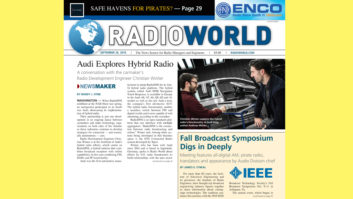In the Aug. 15 issue of Radio World, the author described her participation in the NAB Education Foundation’s 2018 Technology Apprenticeship Program. We invited her to share her impressions as the apprenticeship comes to a close.

Readers of Radio World, two months of working as an engineering apprentice at iHeartMedia in Greensboro, N.C., has given me a greater variety of experiences than I could have ever imagined. These experiences ranged from the terribly exciting to the rather mundane, but all of them were invaluable lessons. I have the TAP Program to thank for that.
About a month into my apprenticeship, I rode 45 minutes out to the “dump site,” the dingiest transmitter site of the four in our market, at 10 p.m. During an impending thunderstorm, I met up with my two supervising engineers, and we got to work setting up inside. We pulled up the weather radar, tracking the storm as it progressed, mindful of the danger of replacing a transmitter tube in the middle of potential lightning.
Keeping a close eye, we got to work replacing the tube, which had been slowly draining of life for some time. The suspected issue to start with was that the tube was running too hot. But what may have been a simple enough endeavor to start with turned into a four-hour process when we realized that the replacement tube was “open,” and when we nestled it into the tube socket, no connection was made. It was a dud.
We then made the effort to return the old tube to its rightful place for the time being, but quickly realized that the tube was not sitting right in the tube socket. The culprit? Bent and broken clamps, which were also likely to blame for the initial problem. There was a poor connection, and the old tube was working overtime.
We didn’t get to replace the tube; but spending four hours in that slightly dingy, freezing transmitter site in the middle of the night and troubleshooting as we went along was one of the coolest parts about my apprenticeship.
NEW SKILLS, CAREER QUESTIONS
During my time at iHeartMedia, I’ve been allowed to be hands-on and work independently, putting new skills I’ve learned to use — whether that be something as simple as drilling a pilot hole into a wall or as exciting as soldering XLR connectors to cables. I’ve been met with many challenges, from conquering my fear of heights and climbing ladders to run cable under ceiling tiles to coming home with cuts and bruises from lifting, bending, cutting and crawling into small spaces.
Through it all, working with the engineering team at iHeart was an absolute joy. All three men who mentored me know their trade and were always willing to answer my questions, provided I made the effort to slow them down while they were troubleshooting an antenna issue and running a mile-a-minute. Everyone else I worked with, from on-air talent, to promotions, to sales people, treated me like a member of the team and were far more trusting when I would stop by to replace a piece of their computer hardware than I would have ever expected.
Choosing broadcast engineering as a potential career path is by no means off the table, but there were some facets of the job and the radio industry in general that have given me pause.
I sense that some in the industry feel, at times, a sense of impending doom. This phrase may be overdramatic, and I’m speaking generally now rather than about a specific cluster or company. But at least some people I’ve talked to in radio were concerned enough by the effects of consolidation, mergers of studio locations and all-consuming automation to nudge me slightly toward pursuing engineering in a different industry, if that’s the career path I end up choosing.
Cost efficiencies, I’m told, often lead to engineering teams being stretched thin, responsible for facilities at multiple locations; even then the fear of losing one’s job on short notice seems to be a real concern for many. A lack of job security generally was my unfortunate impression regarding broadcast engineering as a potential career path.
OTHER OBSERVATIONS
As someone who grew up listening to local radio, it was easy to take the medium for granted and to always just expect it to be there, never thinking too deeply into the “how it happens” and the “why it works.” Though I’d clearly wondered about that more in recent years, it was still shocking to discover once inside the radio station just how easy it was to take an entire station off the air accidentally.
I had to learn to be alert and adamant about where I was stepping, and which cord I was grabbing. There are times when a cable is unmarked but is in the way or in the wrong spot, and you must simply yank it out, hoping to not hear your phone buzzing two seconds later, a coworker demanding to know why their internet connection was just lost. Oftentimes, in the face of completely unrelated issues or human error, people still look to engineering to lay the blame. Engineers keep the heart of the studios beating, and that can seem a daunting task on some days.
As I write, my apprenticeship is winding down, and my fellow TAP participants and I are making rundowns and finalizing scripts for the live webcast we will produce at the NAB headquarters in Washington in September. We’ve been documenting our apprenticeship journeys through video journals and photographs, and we have been keeping each other posted on how things are going.
My experience has been exciting and eye-opening, leaving me with a deeper appreciation for the things engineers face and accomplish day-to-day on the job. The impression is likely to be a long-lasting one, and the lessons I’ve learned will remain with me as I navigate a future career, whether it be in engineering or another industry altogether. The program has been nothing short of a blessing.
Thank you for reading.
Comment on this or any story to [email protected].












